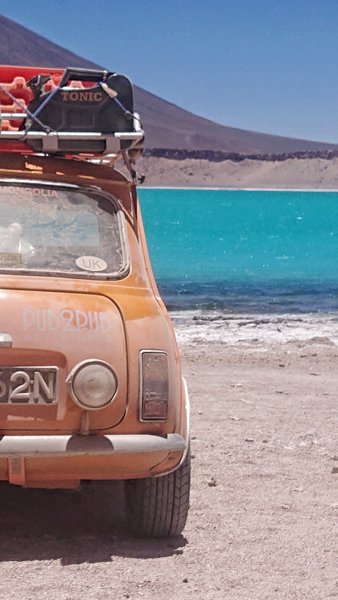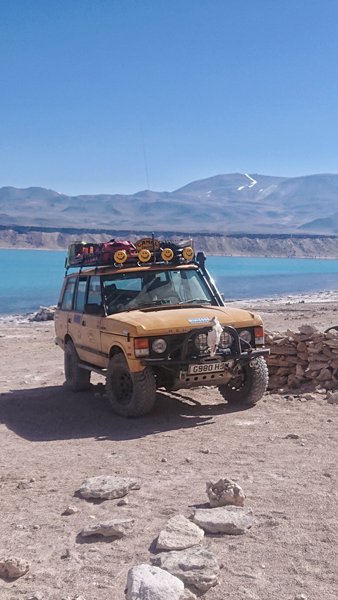On the up: Mini 6000 Expedition Leg 3
As the Mini6000 Expedition heads up into the thin air of the High Atacama Ben Coombs gives some advice on how you can safely undertake your own high altitude road trip.
Altitude. It’s something we usually associate with flying, rather than driving. But there are a few parts of the world where elevation becomes something to be considered in your road trip planning, and the high vistas of the Andes, which stretch down through South America through from Colombia to Patagonia, are one of these places.
As we drove out of the Chilean town of Copiapo, and up into the High Atacama, the road climbed rapidly, reaching an altitude of 3,000 metres after only 70 miles on the road. Now, 3,000 metres is something of a magic number when it comes to planning a high altitude road trip. Below this elevation, anything goes, and generally, no consideration needs to be given to the thin air. This is why the roads of the European Alps, which top out just below this height, require no specific health warnings.
However when planning a road trip which reaches over 3,000 metres – as you might in the Andes, and parts of Asia or North America – you need to take the risks of thin air seriously. Fortunately, thanks to the world of mountain medicine, living safely at such elevations is well understood. Here are a few rules to work by if you find yourself considering such an adventure:
Firstly, it is possible to go from low down to elevations over 3,000 metres briefly, provided you descend quickly and don’t sleep high up. Many of the cable cars in the Alps will take you to altitudes approaching 4,000 metres, and can be used safely provided you descend to sleep, or if you start to feel ill or out of breath. The same is true of driving over high passes – provided the drive up and down a pass can be made in a day, it can be considered achievable.
But what if you wish to spend an extended period of time driving the high plateaus of the Andes, as we will be during Mini6000? In that case, you’ll need to acclimatise. It will pay to do some further reading on this to understand it fully, but as a rule of thumb, once you venture over 3,000 metres, your sleeping altitude should not increase by more than an additional 300 metres per day. Obviously, this rule may need to be bent if accommodation options are few and far between, but it’s a rough rule you should aim to abide by as best you can. And, if venturing high for a long period, be sure to research the dangers of altitude before you go – a thorough understanding of the symptoms of altitude sickness and oedemas could save your life.
But don’t let this put you off planning a high altitude road trip. In a way, it just adds an additional dimension to the adventure – it certainly has for ours.
Abiding by the 3,000 metre rule, after leaving Copiapo our first night was spent wild camping in a remote desert valley, around 3,100 metres above sea level. Just us, our tents, our two cars and down below, the dirt track which had led us there. And such a remote camp is the perfect place from which to experience the Atacama’s best party trick – its night sky. Utterly remote, devoid of light pollution and benefitting from the cloudless, rarefied atmosphere, it’s no co-incidence that the highest density of astronomical observatories in the world can be found high up in this desert. To camp beneath the shimmering streak of the Milky Way made negotiating the sometimes rough tracks which led us into the desert worth the effort.
As our next camp would be at a considerably higher elevation of 3,760 metres up, we spent two nights at our first wildcamp, hiking higher during the day to help our acclimatisation. And then it was back on the road, for a drive of only 17 miles. Sounds straightforward? It would be, if it weren’t a gravel track, crossing a pass of over 4,000 metres elevation.
Our ascent brought to the fore another consideration which must be taken onboard when planning a high drive – the thin air doesn’t only affect people; it affects cars too. Now, most modern vehicles won’t have a problem at heights of 4,000 or even 5,000 metres above sea level, but if any aspect of your car isn’t optimum, rough roads at high altitude will exploit the weakness. This was certainly the case for Mini6000’s Range Rover, its radiator receiving less and less air as we climbed, the engine running hotter and hotter. Several stops were needed before we crested the pass and coasted down to our overnight stop at Laguna Santa Rosa, 3,760 metres above sea level.
The shores of this beautiful lagoon were to be our home for three nights, as we acclimatised further, and the views of the sky at night were complemented by views of flamingos, guanacos and the 6,000+ metre high mountains of the Tres Cruces by day. Driving to altitude may be challenging and tough at times, but the rewards are certainly there.
For our third acclimatisation stop, we pushed on further into the desert. Corrugated tracks carried us onwards, soft sand stretching the Mini’s traction to the limit – beyond the limit, in fact, as a particularly soft area of sand brought it to a halt on one occasion, necessitating the use of our recovery gear for the first time. But both of our old classics pushed on, climbing ever higher, crossing a high pass of over 4,500 metres before dropping back down to the shores of Laguna Verde, where we set up camp on the shores of the most turquoise waters we’d ever seen, 4,300 metres up, and stayed for the next three nights, as the acclimatisation continued.
While others may rush up into the thinner air faster, we were taking our time, both for safety and because as a small group of four people, we couldn’t afford anyone to be hit by altitude sickness if we were to achieve our goal of getting the Mini up to 6,000 metres.
On one of our days at Laguna Verde, we confronted another of the challenges of an Atacama expedition such as ours – logistics. Already over a week into the expedition, the nearest town was now a 280-mile round trip away. Early one morning, the Range Rover set forth on a supply run, returning after dark laden with food, fuel and water for the party to survive for a week in the wilderness.
And in the wilderness we’d truly be, as with a solid base of acclimatisation in place, and supplies sorted, it was time to head up in the world. Our destination was the slopes of the 6,893 metre high Ojos del Salado, the highest volcano on the planet. Where we were going, up there in the thin air, we wouldn’t need roads. Which was just as well, as there weren’t really any; just the roughest of dirt tracks.
It was time for the adventure to really begin.
Words & Photography Ben Coombs Twitter/X | Instagram















The Mini 6000 Expedition ends with a lengthy drive back to the Atlantic coast.